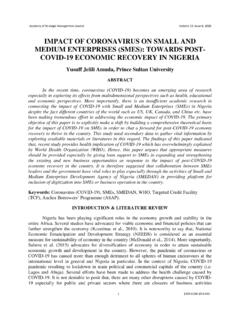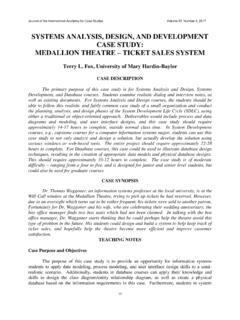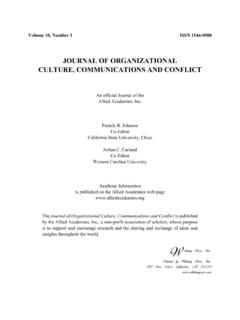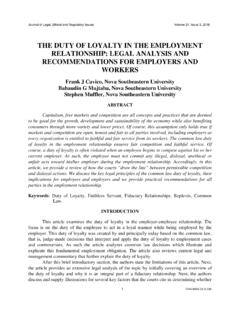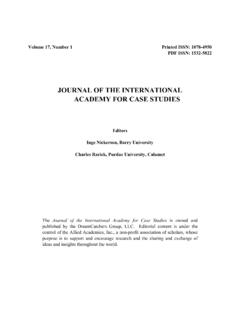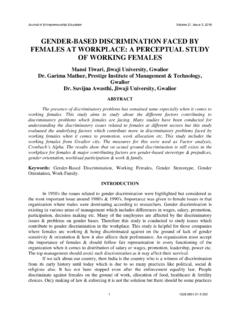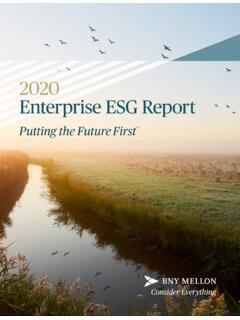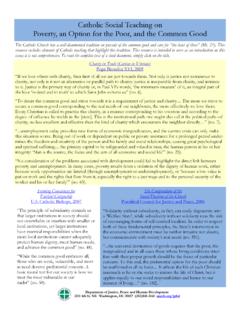Transcription of THE IMPACT OF COMMUNICATION AND GROUP DYNAMICS …
1 Academy of Strategic Management Journal Volume 17, Issue 4, 2018. THE IMPACT OF COMMUNICATION AND GROUP . DYNAMICS ON TEAMWORK EFFECTIVENESS: THE. CASE OF SERVICE sector ORGANISATIONS. Ashish Mohanty, Institute of Management & Information Science Sasmita Mohanty, Siksha O' Anusandhan University ABSTRACT. The present study makes an attempt to study the DYNAMICS of teamwork effectiveness, COMMUNICATION and GROUP DYNAMICS across private banks, hotels and retail sector and to ascertain the relative importance of COMMUNICATION and GROUP DYNAMICS in determining teamwork effectiveness in banks, hotels and retail sector . Three standardized questionnaires namely COMMUNICATION Satisfaction Questionnaire, GROUP Functioning Questionnaire and Team Effectiveness Assessment Measure Questionnaire have been used to collect the data. The sample size is two hundred and ninety seven from private banks, hotels and retail chains in Bhubaneswar city, Odisha.
2 The statistical tools used are descriptive analysis, Analysis Of Variance (ANOVA) and Multiple Regression Analysis to analyse the data and interpret the results. Based on the findings, organisational development and intervention strategies are suggested to enhance teamwork effectiveness in the service sector . Keywords: COMMUNICATION , GROUP DYNAMICS , Teamwork, Service sector . INTRODUCTION. The organisation's success depends upon the members of the team involved in the development process (Verburg et al., 2013). Members belonging to different teams within the organizational structure are truly the flag bearers and the assets of an organization. Today, a large number of the workforce is engaged in jobs that involve more customer interaction and a certain amount of skills and effective COMMUNICATION to carry out their jobs because of the dynamic nature of business. Under such a scenario, employees feel the need for information both internal as well as external to be confident and comfortable at workplace.
3 COMMUNICATION is the lifeline of any organisation and the success of a business enterprise to a great extent depends upon the efficient and effective COMMUNICATION (Bisen & Priya, 2008). Hynes opined that management COMMUNICATION is both challenging and exciting as managers communicated with subordinates in quite different ways in the past than they do today in the 21st century . Organisations often deal with groups of people who have to perform some job which involves multifarious tasks in which they often work in teams (Forsyth, 2010). Complex and complicated processes encompassing enumerable tasks cannot be executed and carried out by an individual, rather, the solution is to have a team of individuals who can perform the similar tasks and work in shortest possible time (Patel et al., 2010). Hence, the importance of COMMUNICATION cannot be over emphasized, demanding the interdependencies within the GROUP (Cherry &.)
4 Robillard, 2008). Lewin rightly called the processes of how groups and individuals act and react 1 1939-6104-17-4-251. Academy of Strategic Management Journal Volume 17, Issue 4, 2018. to changing circumstances as GROUP DYNAMICS (Patel et al., 2010) that considers different aspects of GROUP members' interaction. This is especially true for service sector organisations. The increasing trends in specialization and division of labour in service sector calls for effective COMMUNICATION and GROUP DYNAMICS for overall organizational goal achievement. Interpersonal COMMUNICATION , GROUP DYNAMICS and teamwork is vital in any service sector organization where the services are rendered based upon the intangibility aspect , the interpersonal COMMUNICATION . COMMUNICATION is not just providing information only (Zhu et al., 2004). It fact, it plays a major role as far as the success and failure of any organization is concerned (Orpen, 1997).
5 The goals and objectives of an organization are attained by motivating the employees through effective organizational COMMUNICATION (Clampitt & Downs, 1993). According to ( , 2010), COMMUNICATION in organizations occur at three levels viz., primary, interpersonal, between groups and at an organizational level and also takes place in three major forms, verbal, non-verbal and written (Ober, 2001). Similarly, the direction and flow of COMMUNICATION may be top-down, bottom-up and horizontal or lateral depending upon the hierarchical structure within the organisation (Postmes, 2003). The downward COMMUNICATION is about supervisor to subordinate COMMUNICATION whereas upward COMMUNICATION involves COMMUNICATION from subordinate to supervisor and horizontal or lateral COMMUNICATION is about the COMMUNICATION amongst the peer GROUP . COMMUNICATION among different departments is referred as cross-channel COMMUNICATION (Ober, 2001).
6 The use of groups or teams in organisations is considered an effective response to the dynamic and competitive environments in which organisations operate (Lira et al., 2008). In consideration of the IMPACT of groups on organisational outcomes, organisations are now devoting more time, attention and resources towards research on groups with a strong focus on GROUP performance (Chou & Garcia, 2011) and are becoming more dependent on groups due to the shift towards a flatter and more decentralized organisational structure (Krebs et al., 2006). Lewin (1943) explained about the way small groups and individuals act and react to different circumstances which he called as GROUP DYNAMICS . Lind & Sk rvad (1997) while explaining about a team and a GROUP said that a team is a special type of GROUP , because apart from the fact that they interact with each other, they also work together whereas a team has a common goal, they are integrated, engaged and they have complementing competencies.
7 This theory is also supported by Lew n & Philip (1998). In today's every dynamic and evolving business environment, teams have become the mainstay of any service sector organisations. And, it's all about working with coworkers and team members, toward growth and success of the company (Welbourne et al., 1998). Thus, the emphasis on team role in various work performance models has warranted a change in the way the organisations perform (Borman & Motowidlo, 1997; Campbell, 1990). Consequently, an employee's work effectiveness depends upon his or her ability to manage the team towards teamwork effectiveness. Teamwork is defined by Scarnati (2001) as a cooperative process that allows ordinary people to achieve extraordinary results . Teamwork is increasingly becoming a prerequisite for many job functions in those learning organizations striving towards quality. In this regard, Guzzo & Dickson (1996) argue that team-based forms of organising often bring about higher levels of organisational effectiveness in comparison to traditional, bureaucratic forms.
8 However, there is a daunting task for many managers to create a teamwork environment in organizations from service sector . 2 1939-6104-17-4-251. Academy of Strategic Management Journal Volume 17, Issue 4, 2018. The research on teamwork is either limited or there are a few studies carried out in service delivery organisations. For example, it has focused on areas such as healthcare, where teams are multi-disciplinary with issues such as collegiality, hierarchy and professionalism (Finn et al., 2010; Lloyd & Newell, 2000). Similarly, World Tourism Organization maintains that hotels and catering which is the world's largest industry, there is limited empirical research in particular on teamwork (Salanova et al., 2005). Hospitality industry, banking & retail sector seem intuitively to depend heavily upon effective teamwork. Although a lot of studies have been conducted to understand GROUP DYNAMICS (Janis, 1982; Hoyt & Blascovich, 2003), predict GROUP performance (Kolfschoten et al.)
9 , 2011; Kelly et al., 2011; Bushe & Coetzer, 2007) and improve the quality of GROUP activities (Shapiro et al., 2001; Spring & Vathanophas, 2003) and a number of studies on subgroups in teamwork (Ocker et al., 2011; Carton & Cummings, 2012), there are a few articles or research studies on teamwork in service sector settings and moreover there has been no research undertaken taking all the three concepts namely COMMUNICATION , GROUP DYNAMICS and effective teamwork in their studies, especially in service sector . Therefore, in order to find out to what extent these factors will have any such effects in the service sector within the Odisha context and in particular the private banks, hotels and retail chains in the city of Bhubaneswar, the researchers felt that there is need to investigate and document the above mentioned factors affecting teamwork effectiveness in these service sector organisations.
10 LITERATURE REVIEW. Miller et al. (2018) conducted a systematic review in PubMed and Embase to identify team-building interventions. The evaluated outcomes in four domains were trainee evaluations, teamwork attitudes/knowledge, and team functioning and patient IMPACT . The team-building interventions were generally positive while evaluating trainees, but, only one study associated team-building with statistically significant improvement in teamwork attitudes/knowledge. Sanyal & Hisam (2018) carried out a study to analyse the IMPACT of teamwork on the employees of Dhofar University. The results reveal that there is a strong and significant connection between the independent variables viz. teamwork, climate of trust, leadership and structure, performance evaluation and rewards and the performance of the employees of the university. McEwan et al. (2017) conducted a systematic review and meta-analysis of teamwork interventions that were carried out with the purpose of improving teamwork and team performance, using controlled experimental designs.
